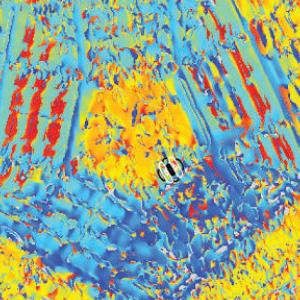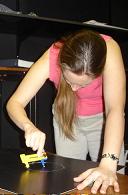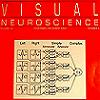Current
Former

James O’Keeffe
Lab member October 2018 – December 2020
James was funded by the Leverhulme Trust to work on our mantis vision project as our computational neuroscientist. James did an EPSRC-funded PhD in Electronic Engineering at York University, looking at bio-inspired adaptive fault diagnosis for swarm robotic systems. James has a BSc (Hons) in Physics from Queen Mary University of London, following which he spent a year working as a Graduate Physicist investigating autonomous UAV systems at QinetiQ. He specialises in autonomous systems, software engineering and robotics. He is now a research associate at Imperial, working on autonomous UAV systems for use in sustainable agriculture.
Publications with O’Keeffe J
Nityananda V, O’Keeffe J, Umeton D, Simmons A, Read JCA (2019)Second-order cues to figure motion enable object detection during prey capture by praying mantises
PNAS

Ronny Rosner
Lab member January 2014 – March 2020
Ronny was funded by the Leverhulme Trust to work on our mantis vision project as our neurophysiologist. Ronny did his PhD at Bielefeld University in Germany, looking at the variability of visual information processing in the optic lobes and descending pathways of blowflies. In his postdoctoral work at the University of Marburg, he examined the central complex, a structure in insect brains which seems to play roles in spatial orientation and visually guided movement. At Newcastle, Ronny set up an electrophysiology lab and developed suitable techniques for examining the responses of mantis neurons to stereoscopic stimuli. He discovered the first invertebrate neurons tuned to binocular disparity, revealing circuits much more complex than anticipated.
Publications with Rosner R
Nityananda V, Tarawneh G, Rosner R, Nicolas J, Crichton S, Read JCA (2016)Insect stereopsis demonstrated using a 3D insect cinema
Scientific Reports 6 18718
Tarawneh G, Nityananda V, Rosner R, Errington S, Herbert W, Cumming BG, Read JCA, Serrano-Pedraza I (2017)
Invisible noise obscures visible signal in insect motion detection
Scientific Reports 7: 3496 1-14
Tarawneh G, Nityananda V, Rosner R, Errington S, Herbert W, Arranz-Paraíso S, Busby N, Tampin J, Read JCA, Serrano-Pedraza I (2018)
Contrast thresholds reveal different visual masking functions in humans and praying mantises
Biology Open 7(4). pii: bio029439. doi: 10.1242/bio.029439.
Tarawneh G, Jones L, Nityananda V, Rosner R, Rind C, Read JCA (2018)
Apparent Motion Perception in the Praying Mantis: Psychophysics and Modelling
Vision 2(3) 32; doi: 10.3390/vision2030032
Rosner R, von Hadeln J, Tarawneh G, Read JCA (2019)
A neuronal correlate of insect stereopsis
Nature Communications 10(1):2845 1-9
Rosner R, Tarawneh G, Lukyanova V, Read JCA (2020)
Binocular responsiveness of projection neurons of the praying mantis optic lobe in the frontal visual field
Journal of Comparative Physiology A https://doi.org/10.1007/s00359-020-01405-x
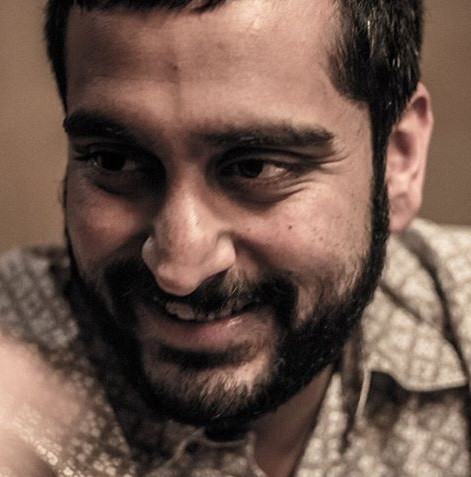
Vivek Nityananda
Lab member September 2013 – May 2019
Vivek was funded by the Leverhulme Trust to work on our praying mantis vision project, and developed 3D glasses to enable us to probe mantids’ 3D stereoscopic vision. He’s now set up his own lab here at Newcastle with a David Phillips Fellowship from the Biology and Biotechnology Research Council. Vivek is interested in sensory ecology and decision making across different model systems. In India, the USA and the UK, he has studied sensory systems in bush crickets (also known as katydids), bees and frogs. Vivek also maintains a great science blog, Stuff Scientists Say, featuring his own unique take on recent publications.
Publications with Nityananda V
Nityananda V, Tarawneh G, Jones L, Busby N, Herbert W, Davies R, Read JCA (2015)The contrast sensitivity function of the praying mantis Sphodromantis lineola
Journal of Comparative Physiology A 201(8) 741-50
Nityananda V, Tarawneh G, Rosner R, Nicolas J, Crichton S, Read JCA (2016)
Insect stereopsis demonstrated using a 3D insect cinema
Scientific Reports 6 18718
Nityananda V, Bissianna G, Tarawneh G, Read JCA (2016)
Small or far away? Size and distance perception in the praying mantis.
Philosophical Transactions B 371(1697) pii: 20150262
Nityananda V, Tarawneh G, Errington S, Serrano-Pedraza I, Read JCA (2017)
The optomotor response of the praying mantis is driven predominantly by the central visual field
Journal of Comparative Physiology A 203 77-87
Nityananda V, Read JCA (2017)
Stereopsis in animals: evolution, function and mechanisms
Journal of Experimental Biology 220 2502-2512
Tarawneh G, Nityananda V, Rosner R, Errington S, Herbert W, Cumming BG, Read JCA, Serrano-Pedraza I (2017)
Invisible noise obscures visible signal in insect motion detection
Scientific Reports 7: 3496 1-14
Nityananda V, Tarawneh G, Henriksen S, Umeton D, Simmons A, Read JCA (2018)
A Novel Form of Stereo Vision in the Praying Mantis
Current Biology 28 (4) 588-593.E4
Tarawneh G, Nityananda V, Rosner R, Errington S, Herbert W, Arranz-Paraíso S, Busby N, Tampin J, Read JCA, Serrano-Pedraza I (2018)
Contrast thresholds reveal different visual masking functions in humans and praying mantises
Biology Open 7(4). pii: bio029439. doi: 10.1242/bio.029439.
Tarawneh G, Jones L, Nityananda V, Rosner R, Rind C, Read JCA (2018)
Apparent Motion Perception in the Praying Mantis: Psychophysics and Modelling
Vision 2(3) 32; doi: 10.3390/vision2030032
Nityananda V, Joubier C, Tan J, Tarawneh G, Read JCA (2019)
Motion-in-depth perception and prey capture in the praying mantis Sphodromantis lineola
Journal of Experimental Biology 222 jeb198614
Nityananda V, O’Keeffe J, Umeton D, Simmons A, Read JCA (2019)
Second-order cues to figure motion enable object detection during prey capture by praying mantises
PNAS
Procenko O, Read JCA, Nityananda V (2024)
Physically stressed bees expect less reward in an active choice judgement bias test
291 (2032) https://doi.org/10.1098/rspb.2024.0512
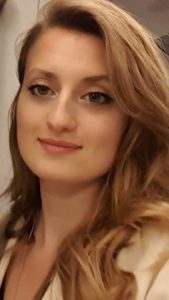 Diana Umeton
Diana Umeton
May 2017 – Jun 2018
Diana worked half-time on our praying mantis vision project, and half-time with Prof Candy Rowe, studying how prey can camouflage themselves from praying mantis predation.
Publications with Umeton D
Umeton D, Read JCA, Rowe C (2017)Unravelling the illusion of flicker fusion
Biology Letters 13 13: 20160831.
Nityananda V, Tarawneh G, Henriksen S, Umeton D, Simmons A, Read JCA (2018)
A Novel Form of Stereo Vision in the Praying Mantis
Current Biology 28 (4) 588-593.E4
Umeton D, Tarawneh G, Fezza E, Read JCA, Rowe C (2019)
Pattern and Speed Interact to Hide Moving Prey
Current Biology 29(18) 3109-3113.e3
Nityananda V, O’Keeffe J, Umeton D, Simmons A, Read JCA (2019)
Second-order cues to figure motion enable object detection during prey capture by praying mantises
PNAS
 Kathleen Vancleef
Kathleen Vancleef
Dec 2014 – Nov 2017
Kathleen Vancleef obtained her PhD in Experimental Psychology at the University of Leuven. She studied the neural mechanisms of contour and texture perception in psychophysical and neuropsychological experiments. Besides this fundamental research questions, she applied her knowledge of perceptual organisation in the development of diagnostic tests for visual perception. As a postdoctoral researcher at the same university, she investigated the influence of brain stimulation on learning of a bimanual task. Kathleen worked on the ASTEROID stereotest project. She managed patient and public involvement and worked closely with the orthoptists and the game developers. Following test development, she evaluated the validity of the test and coordinated the collection of a norm sample. She also completed a project funded by iCURE investigating options to commercialise the test. She is now at Oxford University funded by a fellowship from the Stroke Association.
Publications with Vancleef K
Serrano-Pedraza I, Herbert W, Villa-Laso L, Widdall M, Vancleef K, Read JCA (2016)The stereoscopic anisotropy develops during childhood.
Investigative Ophthalmology and Visual Science 57(3) 960-70
Serrano-Pedraza I, Vancleef K, Read JCA (2016)
Avoiding monocular artifacts in clinical stereotests presented on column-interleaved digital stereoscopic displays
Journal of Vision 16(14):13 1-14
Vancleef K, Read JCA, Herbert W, Goodship N, Woodhouse M, Serrano-Pedraza I (2017)
Overestimation of stereo thresholds by the TNO stereotest is not due to global stereopsis.
Ophthalmic and Physiological Optics 37(4) 507-520
Ushaw G, Sharp S, Hugill J, Rafiq S, Black C, Casanova T, Vancleef K, Read JCA, Morgan G (2017)
Analysis of Soft Data for Mass Provision of Stereoacuity Testing Through a Serious Game for Health
Proceedings of the 2017 International Conference on Digital Health (DH '17). ACM, New York, NY, USA. 6 216-220
Vancleef K, Read JCA, Herbert W, Goodship N, Woodhouse M, Serrano-Pedraza I (2018)
Two choices good, four choices better: For measuring stereoacuity in children, a four-alternative forced-choice paradigm is more efficient than two
PLoS ONE 13(7): e0201366 1-15
Vancleef K, Read JCA (2019)
Which Stereotest do You Use? A Survey Research Study in the British Isles, the United States and Canada
British and Irish Orthoptic Journal 15(1) 15–24
Vancleef K, Serrano-Pedraza I, Sharp C, Slack G, Black C, Casanova T, Hugill J, Rafiq S, Burridge J, Puyat V, Ewane Enongue J, Gale H, Akotei H, Collier Z, Haggerty H, Smart K, Powell C, Taylor K, Clarke MP, Morgan G, Read JCA (2019)
ASTEROID: A New Clinical Stereotest on an Autostereo 3D Tablet
Translational Vision Science and Technology 8(1): 25 1-24
Read JCA, Rafiq S, Hugill J, Casanova T, Black C, O'Neill A, Puyat V, Haggerty H, Smart K, Powell C, Taylor K, Clarke MP, Vancleef K (2019)
Characterizing the Randot Preschool stereotest: Testability, norms, reliability, specificity and sensitivity in children aged 2-11 years
PLOS ONE 14(11)
Serrano-Pedraza I, Vancleef K, Herbert W, Goodship N, Woodhouse M, Read JCA (2020)
Efficient estimation of stereo thresholds: What slope should be assumed for the psychometric function?
PLOS ONE
Casanova T, Black C, Rafiq S, Hugill-Jones J, Read JCA, Vancleef K (2020)
The impact of active research involvement of young children in the design of a new stereotest
Research Involvement and Engagement 6 (29) https://doi.org/10.1186/s40900-020-00194-6

Ghaith Tarawneh
June 2013 – 2016
Ghaith was funded by the Leverhulme Trust to work on our mantis vision project. Ghaith has a PhD in Microelectronic Circuit Design and an MSc in Mechatronics, both from Newcastle University, and a BSc in Computer Engineering from Princess Sumaya University for Technology in Jordan. Ghaith is currently implementing automated detection and classification of mantis visual responses, which will make all our subsequent behavioural experiments vastly quicker, easier and more sensitive.
Publications with Tarawneh G
Nityananda V, Tarawneh G, Jones L, Busby N, Herbert W, Davies R, Read JCA (2015)The contrast sensitivity function of the praying mantis Sphodromantis lineola
Journal of Comparative Physiology A 201(8) 741-50
Tarawneh G, Read JCA (2014)
An FPGA-based hardware accelerator for simulating spatiotemporal neurons
Electronics, Circuits and Systems (ICECS), 21st IEEE International Conference on 2014 618 - 621
Nityananda V, Tarawneh G, Rosner R, Nicolas J, Crichton S, Read JCA (2016)
Insect stereopsis demonstrated using a 3D insect cinema
Scientific Reports 6 18718
Nityananda V, Bissianna G, Tarawneh G, Read JCA (2016)
Small or far away? Size and distance perception in the praying mantis.
Philosophical Transactions B 371(1697) pii: 20150262
Nityananda V, Tarawneh G, Errington S, Serrano-Pedraza I, Read JCA (2017)
The optomotor response of the praying mantis is driven predominantly by the central visual field
Journal of Comparative Physiology A 203 77-87
Tarawneh G, Nityananda V, Rosner R, Errington S, Herbert W, Cumming BG, Read JCA, Serrano-Pedraza I (2017)
Invisible noise obscures visible signal in insect motion detection
Scientific Reports 7: 3496 1-14
Nityananda V, Tarawneh G, Henriksen S, Umeton D, Simmons A, Read JCA (2018)
A Novel Form of Stereo Vision in the Praying Mantis
Current Biology 28 (4) 588-593.E4
Tarawneh G, Nityananda V, Rosner R, Errington S, Herbert W, Arranz-Paraíso S, Busby N, Tampin J, Read JCA, Serrano-Pedraza I (2018)
Contrast thresholds reveal different visual masking functions in humans and praying mantises
Biology Open 7(4). pii: bio029439. doi: 10.1242/bio.029439.
Tarawneh G, Jones L, Nityananda V, Rosner R, Rind C, Read JCA (2018)
Apparent Motion Perception in the Praying Mantis: Psychophysics and Modelling
Vision 2(3) 32; doi: 10.3390/vision2030032
Rosner R, von Hadeln J, Tarawneh G, Read JCA (2019)
A neuronal correlate of insect stereopsis
Nature Communications 10(1):2845 1-9
Umeton D, Tarawneh G, Fezza E, Read JCA, Rowe C (2019)
Pattern and Speed Interact to Hide Moving Prey
Current Biology 29(18) 3109-3113.e3
Nityananda V, Joubier C, Tan J, Tarawneh G, Read JCA (2019)
Motion-in-depth perception and prey capture in the praying mantis Sphodromantis lineola
Journal of Experimental Biology 222 jeb198614
Rosner R, Tarawneh G, Lukyanova V, Read JCA (2020)
Binocular responsiveness of projection neurons of the praying mantis optic lobe in the frontal visual field
Journal of Comparative Physiology A https://doi.org/10.1007/s00359-020-01405-x
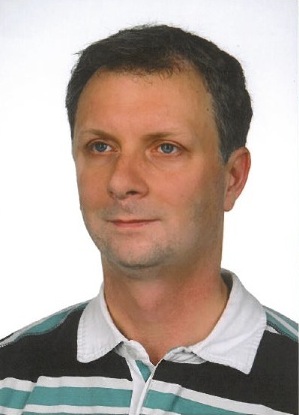
Iwo Bohr
Lab member during 2012
Iwo worked on a project investigating 3D TV, analysing optometric, orthoptic and other data. He is still at Newcastle but now working with Professor Andy Blamire, using MRI to investigate etiology of white matter hyperintensities.
Publications with Bohr I
Bohr I, Read JCA (2013)Stereoacuity with Frisby and revised FD2 stereo tests
PLOS ONE 8(12) e82999
Read JCA, Bohr I (2014)
User experience while viewing stereoscopic 3D television
Ergonomics 57(8) 1140-53
Read JCA, Simonotto J, Bohr I, Godfrey A, Galna B, Rochester L, Smulders TV (2015)
Balance and coordination after viewing stereoscopic 3D television
Royal Society Open Science 2 140522
Read JCA, Godfrey A, Bohr I, SImonotto J, Galna B, Smulders TV (2016)
Viewing 3D TV over two months produces no discernible effects on balance, coordination or eyesight.
Ergonomics Jan 13 1-16
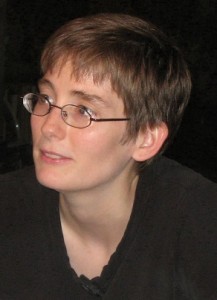
Jennifer Simonotto
Lab member 2011 – 2012
Jennifer worked on a project investigating 3D TV. She helped develop the analysis of tri-axial accelerometer data. She is now at Imperial College London.
Publications with Simonotto J
Read JCA, Simonotto J, Bohr I, Godfrey A, Galna B, Rochester L, Smulders TV (2015)Balance and coordination after viewing stereoscopic 3D television
Royal Society Open Science 2 140522
Read JCA, Godfrey A, Bohr I, SImonotto J, Galna B, Smulders TV (2016)
Viewing 3D TV over two months produces no discernible effects on balance, coordination or eyesight.
Ergonomics Jan 13 1-16
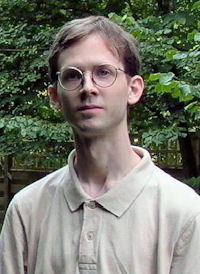
Fredrik Allenmark
Lab member 2008 – 2012
Fredrik was formerly my PhD student and was then employed for one year on a grant from the NHS Flexibility and Sustainability Award scheme, developing visual stimuli to test mechanisms of double and single vision in a variety of clinical groups. He is now working with Florian Waszak at the University Paris Descartes.
Publications with Allenmark PF
Allenmark PF, Read JCA (2010)Detectability of sine- versus square-wave disparity gratings: a challenge for current models of depth perception
Journal of Vision 10(8):17 1-16
Allenmark PF, Read JCA (2011)
Spatial stereoresolution for depth corrugations may be set in primary visual cortex
PLoS Computational Biology 7(8) e1002142
Allenmark PF, Read JCA (2012)
Conjunctions between motion and disparity are encoded with the same spatial resolution as disparity alone
Journal of Neuroscience 32(41) 14331–14343
Read JCA, Allenmark PF (2013)
Visual Perception: One World from Two Eyes
Current Biology 23(11) R483-R486
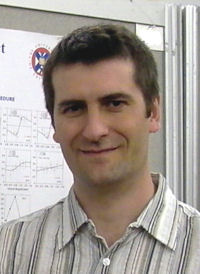
Ignacio Serrano-Pedraza
Lab member 2008 – 2010
Ignacio obtained his PhD in Experimental Psychology from the Universidad Complutense, Madrid, Spain, in 2005. He then spent three years working as a Senior Research Assistant with Andrew Derrington at Newcastle and Kent, before returning to Newcastle as my first post-doc, supported by an award from the Medical Research Council. During his time in my lab, Ignacio published several papers investigating how the stereo vision system detects, encodes and uses vertical disparity. In collaboration with Mr Michael Clarke, a consultant paediatric ophthalmologist at the Royal Victoria Infirmary, he also studied how binocular vision is altered in children with intermittent exotropia. He left my lab in December 2010 to take up a lectureship at the Universidad Complutense de Madrid. However I’m delighted to say that, as you can see from the publication list below, we continue to tackle research problems together.
Publications with Serrano-Pedraza I
Serrano-Pedraza I, Read JCA (2009)Stereo vision requires an explicit encoding of vertical disparity
Journal of Vision 9(4):3 1--13
Serrano-Pedraza I, Phillipson GP, Read JCA (2010)
A specialization for vertical disparity discontinuities
Journal of Vision 10(3):2 1-25
Read JCA, Phillipson GP, Serrano-Pedraza I, Milner AD, Parker AJ (2010)
Stereoscopic vision in the absence of the lateral occipital cortex
PLoS ONE 5(9) e12608
Serrano-Pedraza I, Read JCA (2010)
Multiple channels for horizontal, but only one for vertical corrugations? A new look at the stereo anisotropy
Journal of Vision 10(12):10 1–11
Serrano-Pedraza I, Clarke MP, Read JCA (2011)
Single vision during ocular deviation in intermittent exotropia
Ophthalmic and Physiological Optics 31 45-55
Serrano-Pedraza I, Manjunath V, Osunkunle O, Clarke MP, Read JCA (2011)
Visual suppression in intermittent exotropia during binocular alignment
Investigative Ophthalmology and Vision Science 52(5) 2352-2364
Serrano-Pedraza I, Hogg EL, Read JCA (2011)
Spatial non-homogeneity of the antagonistic surround in motion perception
Journal of Vision 11(2):3 1–9
Read JCA, Vaz X, Serrano-Pedraza I (2011)
Independent mechanisms for bright and dark image features in a stereo correspondence task
Journal of Vision 11(12):4 1-14
Serrano-Pedraza I, Grady J, Read JCA (2012)
Spatial frequency bandwidth of surround suppression tuning curves
Journal of Vision 12(6):24 1-11
Serrano-Pedraza I, Brash C, Read JCA (2013)
Testing the horizontal-vertical stereo anisotropy with the critical-band masking paradigm
Journal of Vision 13(11):15 1-15
Serrano-Pedraza I, Romero-Ferreiro V, Read JCA, Diéguez-Risco T, Bagney A, Caballero-González M, Rodríguez-Torresano J, Rodriguez-Jimenez J (2014)
Reduced visual surround suppression in schizophrenia shown by measuring contrast detection thresholds
Frontiers in Psychology 5
Read JCA, Georgiou R, Brash C, Yazdani P, Whittaker R, Trevelyan A, Serrano-Pedraza I (2015)
Moderate acute alcohol intoxication has minimal effect on surround suppression measured with a motion direction discrimination task
Journal of Vision 15(1):5 1-14
Yazdani P, Serrano-Pedraza I, Whittaker R, Trevelyan A, Read JCA (2015)
Two common psychophysical measures of surround suppression reflect independent neuronal mechanisms
Journal of Vision 15 (21) 1-14
Serrano-Pedraza I, Herbert W, Villa-Laso L, Widdall M, Vancleef K, Read JCA (2016)
The stereoscopic anisotropy develops during childhood.
Investigative Ophthalmology and Visual Science 57(3) 960-70
Serrano-Pedraza I, Vancleef K, Read JCA (2016)
Avoiding monocular artifacts in clinical stereotests presented on column-interleaved digital stereoscopic displays
Journal of Vision 16(14):13 1-14
Nityananda V, Tarawneh G, Errington S, Serrano-Pedraza I, Read JCA (2017)
The optomotor response of the praying mantis is driven predominantly by the central visual field
Journal of Comparative Physiology A 203 77-87
Vancleef K, Read JCA, Herbert W, Goodship N, Woodhouse M, Serrano-Pedraza I (2017)
Overestimation of stereo thresholds by the TNO stereotest is not due to global stereopsis.
Ophthalmic and Physiological Optics 37(4) 507-520
Tarawneh G, Nityananda V, Rosner R, Errington S, Herbert W, Cumming BG, Read JCA, Serrano-Pedraza I (2017)
Invisible noise obscures visible signal in insect motion detection
Scientific Reports 7: 3496 1-14
Peterzell DH, Serrano-Pedraza I, Widdall M, Read JCA (2017)
Thresholds for sine-wave corrugations defined by binocular disparity in random dot stereograms: Factor analysis of individual differences reveals two stereoscopic mechanisms tuned for spatial frequency
Vision Research 141 127-135
Tarawneh G, Nityananda V, Rosner R, Errington S, Herbert W, Arranz-Paraíso S, Busby N, Tampin J, Read JCA, Serrano-Pedraza I (2018)
Contrast thresholds reveal different visual masking functions in humans and praying mantises
Biology Open 7(4). pii: bio029439. doi: 10.1242/bio.029439.
Vancleef K, Read JCA, Herbert W, Goodship N, Woodhouse M, Serrano-Pedraza I (2018)
Two choices good, four choices better: For measuring stereoacuity in children, a four-alternative forced-choice paradigm is more efficient than two
PLoS ONE 13(7): e0201366 1-15
Vancleef K, Serrano-Pedraza I, Sharp C, Slack G, Black C, Casanova T, Hugill J, Rafiq S, Burridge J, Puyat V, Ewane Enongue J, Gale H, Akotei H, Collier Z, Haggerty H, Smart K, Powell C, Taylor K, Clarke MP, Morgan G, Read JCA (2019)
ASTEROID: A New Clinical Stereotest on an Autostereo 3D Tablet
Translational Vision Science and Technology 8(1): 25 1-24
Serrano-Pedraza I, Vancleef K, Herbert W, Goodship N, Woodhouse M, Read JCA (2020)
Efficient estimation of stereo thresholds: What slope should be assumed for the psychometric function?
PLOS ONE
Arranz-Paraiso S, Read JCA, Serrano-Pedraza I (2021)
Reduced surround suppression in monocular motion perception
Journal of Vision 21, 10 https://doi.org/10.1167/jov.21.1.10

Deborah Buck
Lab member May – Aug 2010
Debbie usually works in the Eye Clinic at the Royal Victoria Infirmary but spent a couple of months with us. She received support from the NHS’s Flexibility and Sustainibility funding in order to help study visual perception in intermittent exotropia and develop new tests of stereo vision for use in the clinic.









